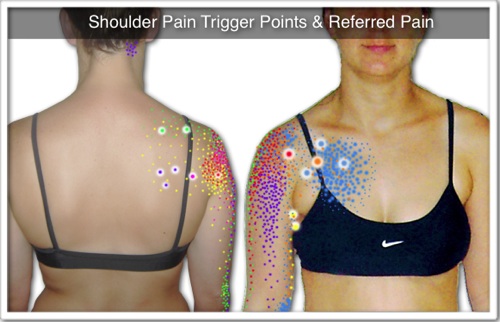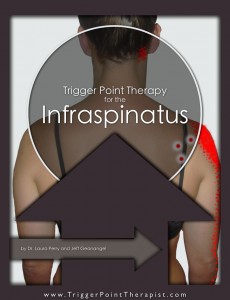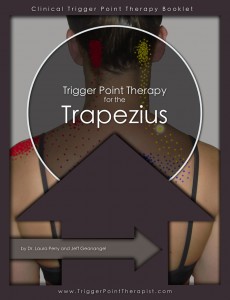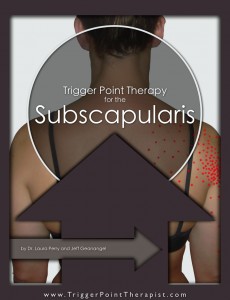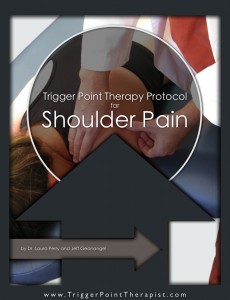Shoulder pain disorders can be the most stubborn and complex cases of myofascial pain imaginable, and just when you think you are making progress they seem to transmute into a mutli-headed monster of pain and dysfunction. After battling this monster in my clinical practice for over a decade, I can tell you that the key to success is a comprehensive attack. This article is intended to provide you with a basic map of the battlefield, to show you what you need to know if you are going to have a fighting chance at resolving your client’s shoulder pain.
Shoulder Anatomy & Biomechanics
The first step in identifying what trigger points are involved with a particular pain complaint is to examine the anatomy in the given region. The musculoskeletal anatomy of the shoulder region is quite complex, involving several joints and twenty muscle groups. I’m not going to bore you with all the anatomical and biomechanical details of the shoulder joint here, but there are two important points for you to know:
- Two-For-One Deal: Joints in the body are typically understood as having one part that is fixed in place, and another part that moves relative to the fixed part. In the shoulder joint, both parts of the joint move simultaneously to allow for a greater range of movement. For example, when a person raises their arm to the side, both the arm and the shoulder blade must move to make this happen. The movement that takes place between the arm and the shoulder blade is provided by the glenohumeral joint, while the movement of the shoulder blade is provided by the scapulothoracic joint. The coordination of movement in both joints is clinically termed the scapulohumeral rhythm, and is easily disturbed by trigger point activity in any of the muscles involved.
- Flexibility versus Stability: I find myself perpetually amazed by the form and function of the glenohumeral joint. Nowhere else in the body do you find a joint capable of moving in so many directions and across such a wide range of motion. But this flexibility comes at a price; namely decreased joint stability. The glenohumeral joint could be described as a ball-and-socket joint with only half a socket. So what keeps the joint together and prevents the ball from just slipping out of the socket? In most joints the ligaments perform this function, but in the shoulder joint the muscles take on this task, specifically the rotator cuff muscles. During movements of the shoulder joint, the rotator cuff muscles contract to hold the head of the humerus within the glenoid cavity of the scapula. Trigger point activity in the rotator cuff muscles can prevent them from stabilizing the joint during movement, causing the joint to “catch” or even dislocate.
The biomechanics of the shoulder joint are so intricate that simple injuries will quickly cascade into complex problems as the body attempts to compensate for the weakest link in the motion chain. To correct biomechanical distortions in the shoulder joint, the therapist must comprehensively address trigger points in three sets of muscles:
- Shoulder Blade Muscles: The muscles that move and position the scapula, such as the trapezius, pectoralis, and rhomboid muscles
- Rotator Cuff Muscles: The muscles that stabilize the glenohumeral joint during movement, such as the infraspinatus, supraspinatus, subscapularis, and teres minor muscles.
- Prime Mover Muscles: The muscles that act as the primary movers of the glenohumeral joint, such as the deltoid, pectoralis, and latissimus dorsi muscles.
Interpreting Shoulder Pain Symptoms & Disorders
Many of trigger points that cause shoulder pain can be identified from a client’s presenting symptoms, medical history, and postural presentation. Listed below are some examples of these clues and some information about how each might relate to trigger point activity.
- Arm Immobilization: The client keeps the affected arm immobilized and pinned to their side. When I see this common antalgic (pain-avoiding) posture I usually expect rotator cuff muscle trigger points, so I examine the client for Infraspinatus trigger points, Supraspinatus trigger points, Teres Minor trigger points, and Subscapularis trigger points.
- Painful Shoulder Held Higher: The client unconsciously holds the painful shoulder a little higher than the unaffected shoulder. This usually indicates the presence of both Trapezius trigger points and Levator Scapulae trigger points.
- Painful Shoulder Held Forward: The client holds the painful shoulder forward as compared to the unaffected shoulder. I am expecting active Pectoralis Major trigger points when I see this.
- Unable To Reach Behind Their Back: The client may complain that they are unable to reach behind their back to take their wallet out of a back pocket, fasten a bra, or put a coat on. This indicates active Infraspinatus Trigger Points and other rotator cuff trigger points.
- Unable To Bring Their Hand To Their Head: If the painful shoulder is on their dominate side, the client may report that they cannot bring their arm up to brush their teeth or comb their hair. Upon hearing this, I will investigate for active Supraspinatus trigger points and Infraspinatus trigger points.
- Shoulder Pain When Lifting Arm: Most clients will report shoulder pain when lifting their arm to their side (arm abduction). If the arm abduction is restricted to about 45 degrees, then active Subscapularis trigger points are the primary culprit. Supraspinatus trigger points may also cause pain during arm abduction.
- Shoulder Catch: Some clients may experience a very painful “catch” in the shoulder when the arm is raised just 15 degrees. This type of impingement syndrome can be significantly resolved by releasing the Deltoid trigger points and the Supraspinatus trigger points.
- Shoulder Clicking or Shoulder Snapping: Supraspinatus trigger points are known to cause the glenohumeral joint to snap or click during movement. This is thought to be caused by trigger point induced muscle tension interfering with the normal movement of the joint.
- Shoulder Pain At Night: Clients will often complain of shoulder pain at night that disturbs their sleep. Trigger points in the infraspinatus muscle make sleeping on either side nearly impossible. If the client lays on the affected shoulder the weight of the body will compress the trigger points, but if the client lays on the pain-free shoulder the upper arm hangs down and painfully stretches the involved infraspinatus muscle. Trigger points in the Supraspinatus muscle may also produce an aching pain at night, but one that does not usually disturb sleep.
- Frozen Shoulder or Adhesive Capsulitis: Clients may have been previously diagnosed as having “frozen shoulder” or adhesive capsulitis. This condition is often mimicked by the symptoms associated with Subscapularis trigger points, earning these trigger points the label of the “frozen shoulder trigger points.”
- Rotator Cuff Tear or Rotator Cuff Strain: Trigger point induced tension in the rotator cuff muscles can predispose their tendons to strain and subsequent tearing or rupture. While surgical repair is sometimes warranted, releasing the rotator cuff trigger points is an effective preventative measure to the degradation of this condition and can also significantly enhance the healing process after surgery.
- Shoulder Bursitis: While the diagnosis of shoulder bursitis is sometimes used by doctors as a “catchall” term, the focused referred pain from the Teres Minor trigger point will often mimic bursitis symptoms experienced in the posterior shoulder region.
The Shoulder Pain Trigger Points & Referred Pain
A trigger point therapist’s “bread & butter” is analyzing referred pain patterns. Referred pain to the shoulder region can be organized into three subregions: front of shoulder pain, back of shoulder pain, and shoulder blade pain. The trigger points that refer pain to each of these subregions are listed below and ordered from the most commonly involved to the least commonly involved:
- Front of Shoulder Pain:
- Back of Shoulder Pain:
- Shoulder Blade Pain:
- Scalene Trigger Points
- Levator Scapulae Trigger Points
- Trapezius Trigger Points
- Rhomboid Trigger Points
Putting It All Together
As you can see, shoulder pain and dysfunction complaints can involve a mind-boggling amount of trigger points. I have spent many years learning from my shoulder pain cases, and the two lessons that stand out in my mind are:
- A comprehensive approach is essential for success. Shoulder pain is not going to be eliminated with the release of just a couple trigger points, it is going to take a systematic plan of attack to see long-lasting results.
- Sequencing is critical: With so many trigger points participating in this disorder, the interaction between trigger points becomes a major clinical consideration. Determining the proper order to release shoulder pain trigger points is no easy task, it requires a detailed understanding of trigger point therapy and many years of practical experience. Much like a jigsaw puzzle, where the placement of each piece is determined by the shape and positions of the other pieces in the puzzle, a competent trigger point therapy protocol for shoulder pain must consider how all the pieces fit together.
To get up to speed quickly in the fight against the multi-headed shoulder pain monster, consider purchasing the Trigger Point DVD for Shoulder Pain (also available as a video download). Nearly 2 hours in length, the video contains detailed instruction in how to locate and release all the trigger points identified in this article, and most importantly, the proper sequencing to get the job done quickly and effectively.
Related Articles:
- Infraspinatus Trigger Points: The Magicians of Shoulder Pain
- Trapezius Trigger Points Are Like Opinions…Everybody Has One
- Subscapularis Trigger Points: The Icicles of Shoulder Pain
- Supraspinatus Trigger Points: Treating the “Stubborn-atus” Trigger Points
- The Deltoid Trigger Points: What You See Is What You Get
Related Instructional Videos:
